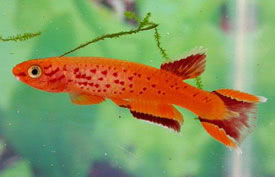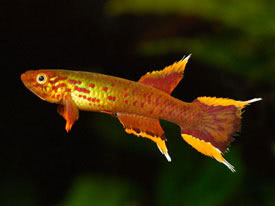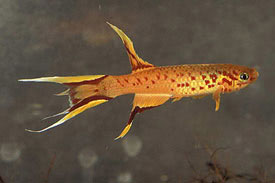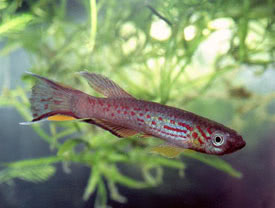
 Magyarul / Hungarian
Magyarul / Hungarian



- Scientific name: Aphyosemion australe
- Synonyms: Panchax polychromus, Haplochilus cameronensis, Aphyosemion polychromum, Aphyosemion hjerresensii
- Common name: Lyretail, Orange lyretail, Cape Lopez Lyretail
- Group: Killifish
- Habitat: Western Africa, the rainforests of Gabon.
- Size: 5 cm
- Biotope: Inhabits shallow shore areas of slow-flowing rivers above a leafy substrate.
- Social behavior: A fine community fish to combine with other small, peaceful species. Keep this species in pairs.
- Diet: Live, flying insects, insect larvae , Brine Shrimp, other crustaceans, Tubifex worms, flakes.
- Breeding: Easy
- Tank: Minimum 25 litres
- Population: 3-4 fish for 30 litres
- Decoration: Use wood, roots, and Java Moss to serve as hiding places. Use a dark substrate, preferably peatmoss. The tank should be densely planted and a cover of floating plants is suggested. Use a tight-fitting cover as this speciesmay leap. This species prefers peat filtration.
- Temperature: 18-22°C
- pH: 6,8-7
- Hardness: 2,6-5,6NK°
- Lifespan: 2-3 years
Description: An elongated fish with elaborate fins. The tips of the anal, caudal, and dorsalfins are elongated and pointed. The outer rays of the caudal fin form a 'lyre-tail' shape. The background body coloration of malesis brownish-yellow to brownish orange. The body is marked with numerous red spots. The fins are orange with a broad yellowand red border. The tips of the fins are white. The females are brown in color with a scattering of red spots.
Males are more colorful, have more elongated fins, and are slightly larger.
A breeding tank measuring 12" (30 cm) with a capacity of 2.4 gallons (9 L) is sufficient. Thewater should have a pH from 6.2-6.8, a water hardness from 2-6 dH, and a temperature from 73 to 77°F (23-25°C). Keepone female with two or three females. Use a spawning mop or fine leafed planted along with a peat moss substrate,if possible. The eggs are hung from plants around the tank. Each day, 10-20 eggs are produced, for a periodof 10-12 days. The peat (containing eggs) should be removed and placed in a separate rearing tank. Replacethe peat moss in the spawning tank. The eggs hatch 10-12 days and once their eggs sacs are consumed, theycan be fed on roftiers and small nauplii.


